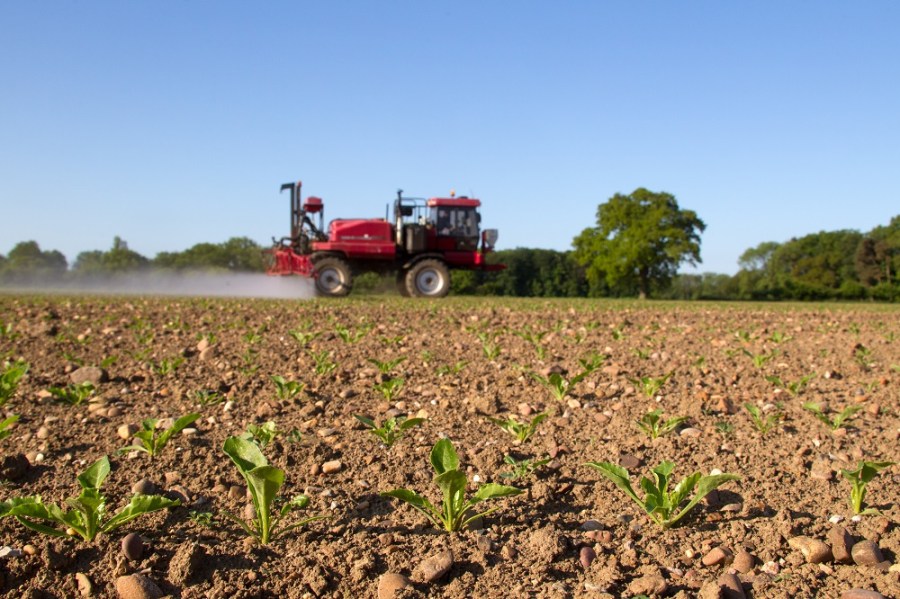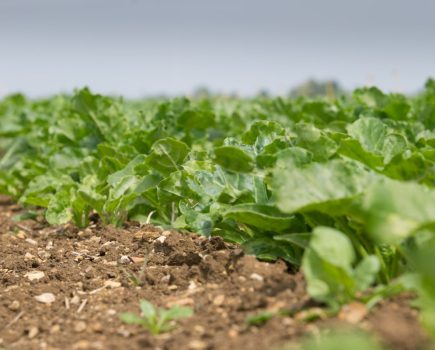Is weed control in sugar beet set to get easier or is managing the crop likely to be more difficult? CPM finds out what growers can expect from the Conviso Smart system which will be available to growers to plant next spring.
Conviso One is a very effective killer of conventional sugar beet
By Lucy de la Pasture
September is the month when thoughts turn to sugar beet seed orders. Just in time, more technical information is emerging about the Conviso Smart system and how it will be introduced in the UK.
The first sugar beet variety to attain a place on the 2020 BBRO Recommended List is Janninka KWS, but it’s the first of new breed of hybrid. Breeder KWS has three other ALS-herbicide tolerant varieties on the National List, so technically available for sale and planting in the UK.

The Conviso system is best suited to whole field situations to avoid accidents with nearby conventional sugar beet varieties.
The technology has been pioneered in conjunction with Bayer. The agrochemical company has developed the new sugar beet herbicide Conviso One (foramsulfuron+ thiencarbazone-methyl). This can only be used with a ‘Smart’ hybrid with the ALS-tolerance trait.
The new system of growing beet is already up and running in 18 other countries (since it first became commercially available in 2018). But there’s a key difference in the UK herbicide label, which limits application of the herbicide to just one 1.0 l/ha dose rather than two of 0.5 l/ha.
Bayer’s Edward Hagues describes Conviso One as covering a wide spectrum of weeds, including some that are notoriously difficult to control. “These include fools parsley, annual mercury, cleavers and polygonums, as well as sensitive grassweeds, including blackgrass.”
For growers with sensitive populations of blackgrass this is good news, but it does mean exposure to another ALS-herbicide with activity against blackgrass within the rotation which means resistance management should be considered. The ALS mode of action has been available for use in sugar beet for the past 20 years in the form of Debut (triflusulfuron-methyl), but it hasn’t offered activity on blackgrass.
“In situations where blackgrass is a concern then we’d recommend a programmed approach incorporating other actives such as Centurion Max (clethodim), as well as a diversity of cropping through the rotation and effective cultural practices,” he suggests.
Conviso One has both contact (both active substances) and residual activity (thiencarbazone-methyl) with the residual component delivering greater efficacy than other products commonly used in sugar beet, but for a similar duration of time, according to Bayer claims.
“The timing of application is later and usually corresponds with the second or third treatment in a conventional herbicide system. This means there’s enough residual (in the one-hit application) to pick up later germinating weeds like fat-hen,” he says.
It’s important to get the timing of the herbicide right and the advice from Bayer is to apply 1.0 l/ha in 150-300 l/ha water using the growth stage of fat-hen as the marker weed, aiming for when it’s at 2-4 leaf stage. The label window for application is crop growth stage 14-18 (four to eight leaves).
The Conviso One can be sequenced with other non-ALS herbicides, but it can’t be mixed with them, clarifies Edward. It can be tank-mixed with insecticides and has a 10m aquatic buffer zone.
One of the main advantages of the new system is the time saving it will offer growers, freeing up the sprayer at a busy time of year and allowing more flexibility, he says. This could be especially valuable as growers track the build-up of aphid populations for Virus Yellows control where getting the timing right is absolutely crucial.
“With less mixing to do, there’s a reduced possibility of mistakes as well as easier handling. Though there is a big proviso – Conviso One is a very effective killer of conventional sugar beet, so it’s crucial to know exactly where the Smart varieties are planted,” says Edward.
According to KWS’s Ben Bishop, the herbicide-tolerant variety has taken more than 20 years of research and development and involved screening 1.5 billion individual sugar beet plants.
“The ALS tolerance is a naturally occurring phenomenon. In Conviso Smart varieties, the ALS-inhibiting herbicide can’t bind with the ALS enzyme, so the sugar beet is able to continue to produce amino acids and growth without any herbicide effect,” he explains.
The trait has been introduced into sugar beet varieties using classic breeding techniques and has a slight yield drag associated with it, as is usual when any new trait is introduced, says Ben. But there is a difference in the system which makes up for this slightly lower yield (91.2%) than in the RL control varieties.
“In trials we’re seeing an uplift in yield from using the Conviso One herbicide of at least 5%, which we believe is down to improved weed control and improved crop safety, and this brings the performance more on a par with the RL control varieties,” he explains.
“Yield is increasing in new varieties and there are now nine in UK trials in 2019. For the first generation of Conviso Smart varieties we recommend sowing from mid-March due to the importance of controlling bolters, which is 3375/ha for Janninka KWS if early sown.”
In order for the Conviso Smart system to remain viable in the long term, stewardship of bolters is going to have to play a big part, says Bayer’s Roger Bradbury. This assumes an even greater importance where growers are considering utilising the new system to bring land back into sugar beet production because it’s had a high weed beet burden.
“Advisers will play a key role in how to incorporate Conviso into rotational planning and there are three main areas to consider; drilling/spraying management, bolter management and herbicide resistance management.
“The Conviso Smart system is best suited to whole field situations. The implications of herbicide drift in a split-field situation are fairly drastic if Conviso One comes into contact with a conventional variety. We also recommend spraying any conventional sugar beet first to avoid any mistakes with the sprayer,” he emphasises.
Another potential problem area is at drilling, when it will be important to clean out the drill thoroughly before switching into or out of Conviso seed, which will be clearly marked on the box to avoid mistakes when loading the drill. The seed will be identified by a purple coloured filler in the pellet and seed boxes will also feature a different colour spout unique to the Conviso Smart system.
“It’s important to clearly mark and record the location of Conviso Smart and then communicate this to anyone who may be carrying out the spraying. After applying the herbicide, the tank should be cleaned using a proprietary cleaner before spraying conventional varieties or other crops,” he adds.
Bolters require a zero-tolerance approach, which is good practice but must be planned for every field. Ploughing is recommended following a Conviso Smart sugar beet crop and then it’s important to monitor for signs of any groundkeepers, he adds.
“If groundkeepers are present then use a herbicide which will kill these which isn’t an ALS-herbicide. Hormone herbicides such as 2,4-D and MCPA have been shown to be effective,” he says.
There’s been some confusion about which crops can be planted following Conviso Smart sugar beet and Edward clears this up. “Winter wheat can be sown in the same year as treatment and in practice it’s the most likely crop to follow beet anyway. In the following year you can plant a wide range of crops including; winter or spring barley, winter or spring wheat, ryegrass, winter oilseed rape, peas, field beans, maize, mustard or sunflowers,” he says.
Unlike the usual arrangement for securing sugar beet seed, Conviso Smart will be supplied through agronomy distribution companies, says Ben.
“To ensure traceability and quality of the herbicide-tolerant seed, KWS will supply the pelleted seed ready for distribution direct to the grower and will act as a licensed agent for the herbicide. The seed and the herbicide will then be sold together (ha packs of seed and herbicides) through Hutchinsons and Frontier in 2020, due to shortages in seed supply. In subsequent years this will include Agrii and Agrovista as more varieties become available,” he explains.
Ben says he believes the system will be competitively priced for the majority of sugar beet growers and KWS has seed availability for less than 10% of forecast crop area in 2020.




